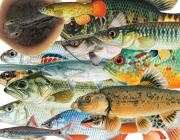For anyone unfamilar with these fascinating, important, and and endangered aridland wetlands, a recent web project focusing on those of New Mexico provides a very nice introduction - see Christina Selby's Las Cénegas storymap project (will open in a new tab).
Hendrickson's initial work on them in the 1980s was summarized in the now widely cited paper:
Hendrickson, Dean A., and W.L. Minckley. 1985. “Ciénegas-Vanishing Climax Communities of the American Southwest.” Desert Plants 6 (3): 130–176. https://doi.org/10/gg5s3w.
and he continued collaborating over the decades with other fans of ciénegas to provide a geospatial database (click here for a map of databased localities) on those of the arid areas of the southwestern US and northwestern México, recently published as
Hendrickson, D. A., Minckley, T. A., Middleton, B. R., & Norman, L. M. (2021). Database of Cienega Locations in Southwestern United States and Northern Mexico [Data set]. U.S. Geological Survey. https://doi.org/10.5066/P91FM1K1
Complementing the new dataset is an extensive North American Ciénegas bibliography, first published in 2016 with help from Tom Minckley and Arturo Contreras-Arquieta, and still periodically updated by Hendrickson, remains openly accessible. If you are a researcher working on ciénegas, or notice localities or literature we may have missed, please help us keep these resources updated.
Cuatrociénegas, Coahuila, México
The valley of Cuatrociénegas, an amazing, complex mixture of desert springs and ciénegas in the Chihuahuan Desert of central Coahuila, México, has long been a focus of Hendrickson's efforts, and of many others, so a large part of the total citations in the bibliographic database are on work done there. This small desert valley harbors an amazing diversity of endemic species, mostly aquatic, but also terrestrial. Beginning in the early 1990's Hendrickson has had projects there studying the fishes and other organisms, and for many years ran a small research station there (with support from Desert Fishes Council and the non-profit DeSuValle A.C.). The objective was to work with the local community to facilitate biological and hydrological research relevant to conservation of this amazing place. Along the way, with local support, Hendrickson organized international meetings of interested researchers in Cuatrociénegas in 2004, 2005 and 2008, each with 100-300 participants, and carried out many projects with the support of the local office of the federal reserve system (CONANP). Unfortunately, diverse factors caused the research station to be closed, but the interest persists and we hope one day to again secure the resources to renew this effort. We continue to maintain our contacts with our many good friends and supporters in the area. Thw bibliography mentioned above can be filtered to display only those papers relevant to Cuatrociénegas.

